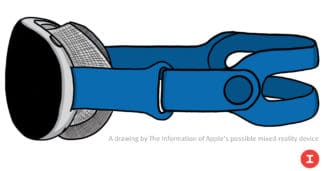Bloomberg, The Information, and supply chain analyst Ming-Chi Kuo all claim Apple plans to release a standalone headset some time in the next year.
The standalone headset market is currently dominated by Meta’s $299 Quest 2. Reports suggest Apple’s headset – codenamed N301 – will be a much higher priced premium product aimed at delivering both virtual reality and mixed reality experiences.
It will reportedly feature color passthrough cameras, very high resolution displays, and a MacBook tier processor – all in a slim and relatively lightweight design.
Here’s everything we’ve heard so far about Apple’s headset:
High Quality Mixed Reality
The existence of Apple’s headset was first reported on by The Information in late 2019. This report claimed N301 will “offer a hybrid of AR and VR capabilities” with cameras “mounted on the outside of the device, allowing people to see and interact with their physical surroundings”.
This report also said Apple executives claimed the headset can “map the surfaces, edges and dimensions of rooms with greater accuracy than existing devices on the market”.
In February 2021 The Information claimed the device has more than a dozen cameras, including eye tracking cameras.
How This Compares: Quest 2 can only show a grainy black & white view of the real world with no automatic scene understanding, but Meta plans to launch a higher end headset this year, codenamed Project Cambria, with color cameras and enhanced mixed reality. French startup LYNX also plans to launch a headset with color mixed reality by July.
Slim & Relatively Light Design
In January 2021 Bloomberg claimed Apple is planning to use “a fabric exterior” to reduce the device’s weight.
In The Information‘s February 2021 report the outlet claimed to have viewed images of a late-stage prototype “which show a sleek, curved visor attached to the face by a mesh material and swappable headbands”, drawing this impression:

In March 2021 Apple supply chain analyst Ming-Chi Kuo claimed prototypes weighed 200-300 grams with a target of 100-200 grams. But in December Kuo revised this claim, saying the first generation model will weigh 300-400 grams while a future second generation will be “significantly lighter”.
How This Compares: Quest 2 weighs just over 500 grams.
High Resolution OLED Microdisplays
The Information‘s February 2021 report claimed Apple’s headset will feature dual 8K screens, but didn’t go into detail about the display technology.
But in November supply chain analyst Ming-Chi Kuo claimed the headset will feature dual 4K OLED microdisplays. This is a much more realistic prospect – The Information could have been misinterpreting dual 4K screens, which some would describe as 8K, as dual 8K.

OLED microdisplays provide the true blacks and infinite contrast of regular OLED displays but are much smaller, enabling very compact headset designs. However, microdisplays are significantly more expensive.
How This Compares: Quest 2 has a resolution of 1832×1920 per eye. The PC VR leader Varjo Aero has a resolution of 2880×2720 per eye.
rOS: A New Operating System
As far back as 2017, Bloomberg reported Apple was working on a new operating system dubbed “rOS” for “reality operating system”.
In December Apple posted a job listing for ‘AR/VR Frameworks Engineer’, with the role described as “developing an entirely new application paradigm” for “software that is deeply integrated into our operating systems”.
In January, iOS Developer Rens Verhoeven spotted a new platform “com.apple.platform.realityos” in the App Store app upload logs.

In February, “award-winning git repository surgeon” Nicolás Álvarez spotted Apple committing code to its open source GitHub repository referencing ‘TARGET_FEATURE_REALITYOS’ and ‘realityOS_simulator’ – the latter likely a feature to allow developers without the headset to test building AR or VR applications.
How This Compares: Quest 2, Vive Focus 3, and Pico Neo 3 Pro all use heavily modified versions of Google’s Android, an OS not designed for low latency VR and AR.
MacBook Level Performance
Ming-Chi Kuo’s November note claimed Apple’s headset will have a new chip with “similar computing power as the M1 for Mac”.
M1 is Apple’s first in-house PC processor, the first in a line intended to transition its Mac products from the x86 architecture that has dominated PCs for two decades to the more power efficient ARM architecture used in smartphones & tablets.
An M1 level chip would outperform any current standalone VR headset, and thus narrow the performance gap between mobile and PC based VR.
How This Compares: Quest 2, Vive Focus 3, and Pico Neo 3 Pro all use Snapdragon XR2, a variant of Qualcomm’s early 2020 flagship smartphone chip. Apple’s M1 is roughly twice as powerful.
“Thimble” Controllers?
The biggest unknown is what input method Apple’s product will use. Bloomberg’s January 2021 report claimed the headset’s high resolution cameras will enable controller-free hand tracking with a floating keyboard for text entry.
But The Information‘s February 2021 report claimed Apple was developing a “thimble-like device to be worn on a person’s finger”.
Shortly after that report, Patently Apple spotted a patent application titled Self-Mixing Interferometry-Based Gesture Input System Including a Wearable or Handheld Device. The patent described a device to “track a user’s finger movements with reference to any surface, including, in some cases, the surface of another finger, the user’s palm, and so on” which”may in some cases be used to provide input to an AR, VR, or MR application“. The filing even cites the example of detecting when the user is holding a stylus, and potentially even providing useful information on what’s being drawn.
How This Compares: Quest 2 and PC VR headsets use gaming focused controllers, which resemble an Xbox or PlayStation controller split into halves for each hand.
Price?
The Information‘s February 2021 report claimed Apple internally discussed pricing the headset around $3000, with a goal of 250,000 units in the first year.
But in Ming-Chi Kuo’s March 2021 note, he said he expects it to be priced around $1000, “similar to a high end iPhone”.
Finally, in January Bloomberg claimed Apple has “weighed prices north of $2000”. Despite this, the report also said Apple is forecasting sales of up to 10 million units in the first year.
While these reports cite widely different price expectations, it’s clear this won’t be a cheap mass market product. Expect a price with four digits, not three.
Release Date?
The Information‘s February 2021 report said Apple was aiming to release the headset in 2022.
In September Taiwanese news outlet DigiTimes claimed mass production was scheduled for Q2 2022, in time for a release in the second half of the year.
Ming-Chi Kuo’s November note predicted the headset will launch in Q4 2022.
However, in January Bloomberg claimed Apple was intending to announce in June at its Worldwide Developer Conference (WWDC) and ship later in the year. But “challenges related to overheating, cameras and software” mean the announcement could be pushed to late this year, and the release into 2023. The overheating issue is said to be caused by trying to use a laptop grade processor in a lightweight headset.







